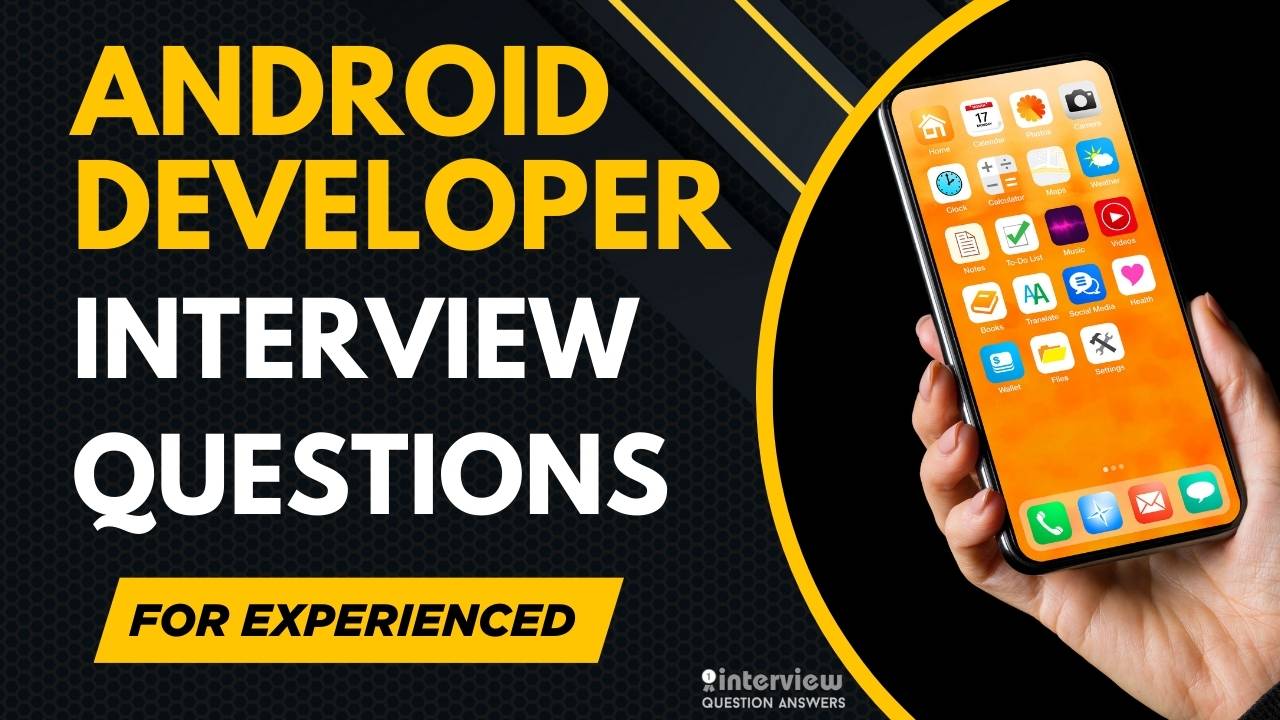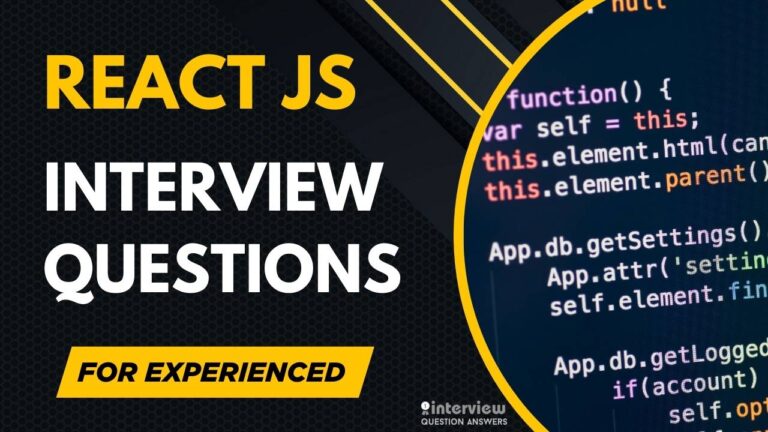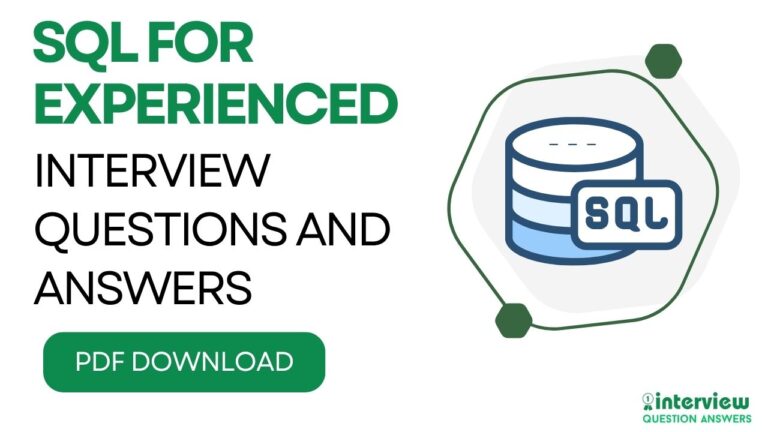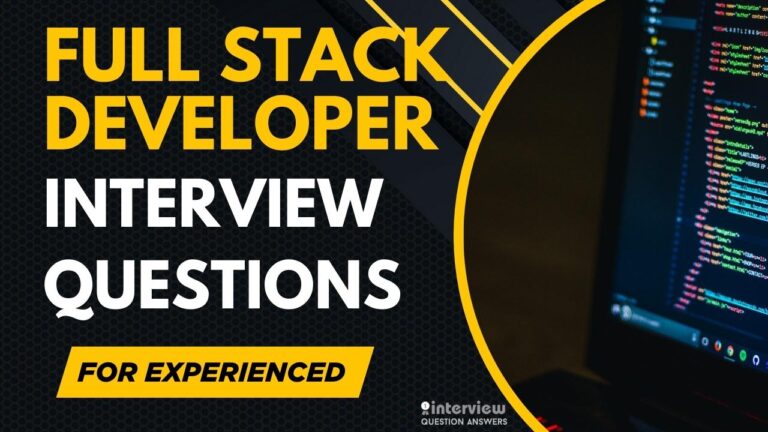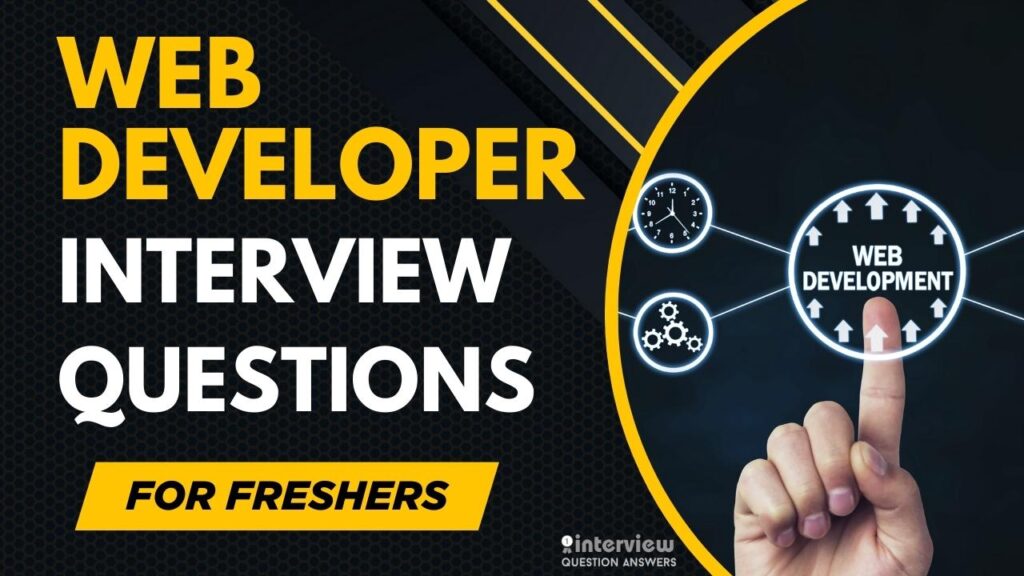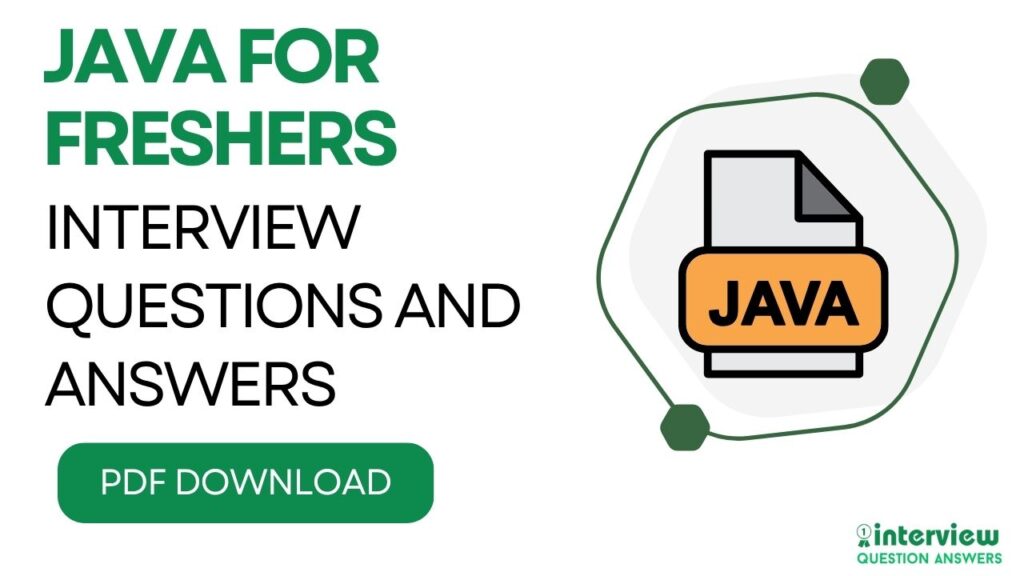Android Developer Interview Questions for Experienced
Our Android Developer Interview Questions for Experienced guide features a comprehensive list of carefully curated questions designed to match the expectations of today’s competitive job market.
This guide helps you master advanced Android concepts such as Jetpack Compose, Kotlin Coroutines, Dependency Injection, Android Architecture Components, and performance optimization techniques. We include real-world scenario-based questions that test your problem-solving skills, design thinking, and ability to write scalable and maintainable code.
With companies rapidly adopting modern Android development practices, staying up to date on topics like modular app development, MVVM architecture, Compose UI, and integrating AI/ML APIs can give you an edge. This guide equips you with the knowledge and confidence to tackle even the toughest questions.
You can also check our another detailed article: Android Developer Interview Questions PDF
Table of Contents
Android Developer Interview Questions for 2 Years Experience
Que 1. How do you manage the Activity lifecycle to prevent crashes during configuration changes?
Answer:
Use ViewModel to persist data across configuration changes like screen rotation. Save instance state in onSaveInstanceState() and restore in onCreate(). Alternatively, lock orientation or use Fragments for modular UI.
class MyViewModel : ViewModel() {
val data = MutableLiveData<String>()
fun setData(value: String) { data.value = value }
}
override fun onSaveInstanceState(outState: Bundle) {
super.onSaveInstanceState(outState)
outState.putString("key", "value")
}Que 2. What is View Binding, and how does it improve upon findViewById()?
Answer:
View Binding generates type-safe binding classes for views, reducing null pointer risks and boilerplate compared to findViewById(). It improves performance and code readability.
private lateinit var binding: ActivityMainBinding
override fun onCreate(savedInstanceState: Bundle?) {
super.onCreate(savedInstanceState)
binding = ActivityMainBinding.inflate(layoutInflater)
setContentView(binding.root)
binding.textView.text = "Hello"
}Que 3. How do you fetch data from a REST API in an Android app?
Answer:
Use Retrofit with Kotlin Coroutines for asynchronous API calls. Define an interface for endpoints, handle responses in a ViewModel, and update the UI.
interface ApiService {
@GET("users")
suspend fun getUsers(): List<User>
}
@HiltViewModel
class UserViewModel @Inject constructor(private val apiService: ApiService) : ViewModel() {
fun fetchUsers() = viewModelScope.launch {
val users = apiService.getUsers()
// Update UI
}
}Que 4. How do you implement navigation in an Android app using Jetpack Navigation?
Answer:
Use a navigation graph to define destinations and actions. Use NavController to navigate between Fragments, ensuring type-safe navigation with safe args.
<!-- nav_graph.xml -->
<navigation xmlns:android="http://schemas.android.com/apk/res/android">
<fragment android:id="@+id/homeFragment" android:name=".HomeFragment">
<action android:id="@+id/action_to_details" app:destination="@id/detailsFragment" />
</fragment>
</navigation>findNavController().navigate(R.id.action_to_details)Que 5. What is the role of Room in Android, and how do you use it?
Answer:
Room is a persistence library for SQLite, providing type-safe database access. Define entities, DAOs, and a database class, using annotations for queries.
@Entity
data class User(@PrimaryKey val id: Int, val name: String)
@Dao
interface UserDao {
@Query("SELECT * FROM user")
suspend fun getAll(): List<User>
}
@Database(entities = [User::class], version = 1)
abstract class AppDatabase : RoomDatabase() {
abstract fun userDao(): UserDao
}Que 6. How do you handle runtime permissions in Android?
Answer:
Use ActivityCompat.requestPermissions() for permissions like location. Handle results in onRequestPermissionsResult() and provide user feedback.
if (ContextCompat.checkSelfPermission(this, Manifest.permission.ACCESS_FINE_LOCATION) != PackageManager.PERMISSION_GRANTED) {
ActivityCompat.requestPermissions(this, arrayOf(Manifest.permission.ACCESS_FINE_LOCATION), 100)
}
override fun onRequestPermissionsResult(requestCode: Int, permissions: Array<String>, grantResults: IntArray) {
if (requestCode == 100 && grantResults[0] == PackageManager.PERMISSION_GRANTED) {
// Permission granted
}
}Que 7. How do you optimize RecyclerView performance?
Answer:
Use ViewHolder pattern, implement DiffUtil for efficient list updates, and enable setHasStableIds(). Cache views and avoid heavy computations in onBindViewHolder.
class MyAdapter : ListAdapter<String, MyViewHolder>(DiffCallback()) {
override fun onCreateViewHolder(parent: ViewGroup, viewType: Int): MyViewHolder {
val view = LayoutInflater.from(parent.context).inflate(R.layout.item, parent, false)
return MyViewHolder(view)
}
override fun onBindViewHolder(holder: MyViewHolder, position: Int) {
holder.bind(getItem(position))
}
}
class DiffCallback : DiffUtil.ItemCallback<String>() {
override fun areItemsTheSame(old: String, new: String) = old == new
override fun areContentsTheSame(old: String, new: String) = old == new
}Que 8. How do you use LiveData in an Android app?
Answer:
LiveData, part of Jetpack, is an observable data holder that respects lifecycle events. Use it in ViewModel to update the UI reactively.
class MyViewModel : ViewModel() {
private val _data = MutableLiveData<String>()
val data: LiveData<String> get() = _data
fun loadData() { _data.value = "Updated" }
}Que 9. How do you handle background tasks in Android?
Answer:
Use WorkManager for deferrable tasks like syncing data. Configure constraints (e.g., network) and schedule one-time or periodic tasks.
val workRequest = OneTimeWorkRequestBuilder<MyWorker>()
.setConstraints(Constraints.Builder().setRequiredNetworkType(NetworkType.CONNECTED).build())
.build()
WorkManager.getInstance(context).enqueue(workRequest)Que 10. What is the difference between ConstraintLayout and RelativeLayout?
Answer:ConstraintLayout uses constraints for flexible, flat hierarchies, ideal for complex layouts. RelativeLayout positions views relative to others or the parent but can create deeper hierarchies, deprecated in favor of ConstraintLayout.
Android Developer Interview Questions for 3 Years Experience
Que 11. How do you secure sensitive data in an Android app?
Answer:
Use EncryptedSharedPreferences or Jetpack Security to encrypt data. Store keys in Android Keystore, use HTTPS for network calls, and obfuscate code with ProGuard.
val masterKey = MasterKey.Builder(context).setKeyScheme(MasterKey.KeyScheme.AES256_GCM).build()
val prefs = EncryptedSharedPreferences.create(context, "secure_prefs", masterKey, AES256_SIV, AES256_GCM)
prefs.edit().putString("secret", "value").apply()Que 12. How do you implement a custom dialog in Android?
Answer:
Create a custom dialog by extending DialogFragment, inflating a custom layout, and handling interactions in onCreateDialog() or onCreateView().
class CustomDialog : DialogFragment() {
override fun onCreateView(inflater: LayoutInflater, container: ViewGroup?, savedInstanceState: Bundle?): View? {
return inflater.inflate(R.layout.custom_dialog, container, false)
}
}Que 13. How do you handle network errors in an Android app?
Answer:
Wrap API calls in try-catch blocks, use sealed classes to represent success/error states, and display user-friendly messages. Retry logic can be added for transient errors.
sealed class Result<out T> {
data class Success<out T>(val data: T) : Result<T>()
data class Error(val exception: Exception) : Result<Nothing>()
}
fun fetchData() = viewModelScope.launch {
try {
val data = apiService.getData()
Result.Success(data)
} catch (e: Exception) {
Result.Error(e)
}
}Que 14. What is the purpose of the Android Keystore system?
Answer:
The Android Keystore securely stores cryptographic keys, protecting them from unauthorized access. It’s used for encryption, decryption, and signing operations.
val keyStore = KeyStore.getInstance("AndroidKeyStore")
keyStore.load(null)
val key = keyStore.getKey("myKey", null)Que 15. How do you implement push notifications using Firebase?
Answer:
Configure Firebase Cloud Messaging (FCM), handle tokens in FirebaseMessagingService, and process incoming messages to display notifications.
class MyFirebaseService : FirebaseMessagingService() {
override fun onMessageReceived(message: RemoteMessage) {
// Show notification
NotificationManagerCompat.from(this).notify(1, buildNotification(message))
}
}Que 16. How do you debug an Android app effectively?
Answer:
Use Android Studio’s Logcat for logs, set breakpoints, and inspect variables. Profile memory and CPU with the Profiler, and test on emulators and real devices.
Log.d("MyApp", "Debug message: $value")Que 17. How do you implement a responsive layout for different screen sizes?
Answer:
Use ConstraintLayout with dp units, provide alternative layouts (e.g., layout-sw600dp), and test with emulators. Use Guideline or Barrier for dynamic positioning.
<androidx.constraintlayout.widget.ConstraintLayout
android:layout_width="match_parent"
android:layout_height="match_parent">
<androidx.constraintlayout.widget.Guideline
android:id="@+id/guideline"
app:layout_constraintGuide_percent="0.5" />
</androidx.constraintlayout.widget.ConstraintLayout>Que 18. How do you use Dependency Injection with Hilt in Android?
Answer:
Use Hilt to inject dependencies into Activities, Fragments, or ViewModels. Define modules for dependencies and annotate classes with @Inject.
@Module
@InstallIn(SingletonComponent::class)
object AppModule {
@Provides
fun provideApiService(): ApiService = Retrofit.Builder().baseUrl("https://api.example.com/").build().create()
}Que 19. How do you test an Android app with unit tests?
Answer:
Use JUnit for unit tests and Mockito for mocking dependencies. Test ViewModels or utility functions, running on JVM for speed.
@Test
fun testViewModel() {
val viewModel = MyViewModel(mockApiService)
viewModel.loadData()
assertEquals("Expected", viewModel.data.value)
}Que 20. How do you handle data persistence with Room and LiveData?
Answer:
Use Room for SQLite persistence with @Entity and @Dao. Combine with LiveData in ViewModel to observe data changes reactively.
@Dao
interface UserDao {
@Query("SELECT * FROM user")
fun getAll(): LiveData<List<User>>
}
@HiltViewModel
class UserViewModel @Inject constructor(private val userDao: UserDao) : ViewModel() {
val users: LiveData<List<User>> = userDao.getAll()
}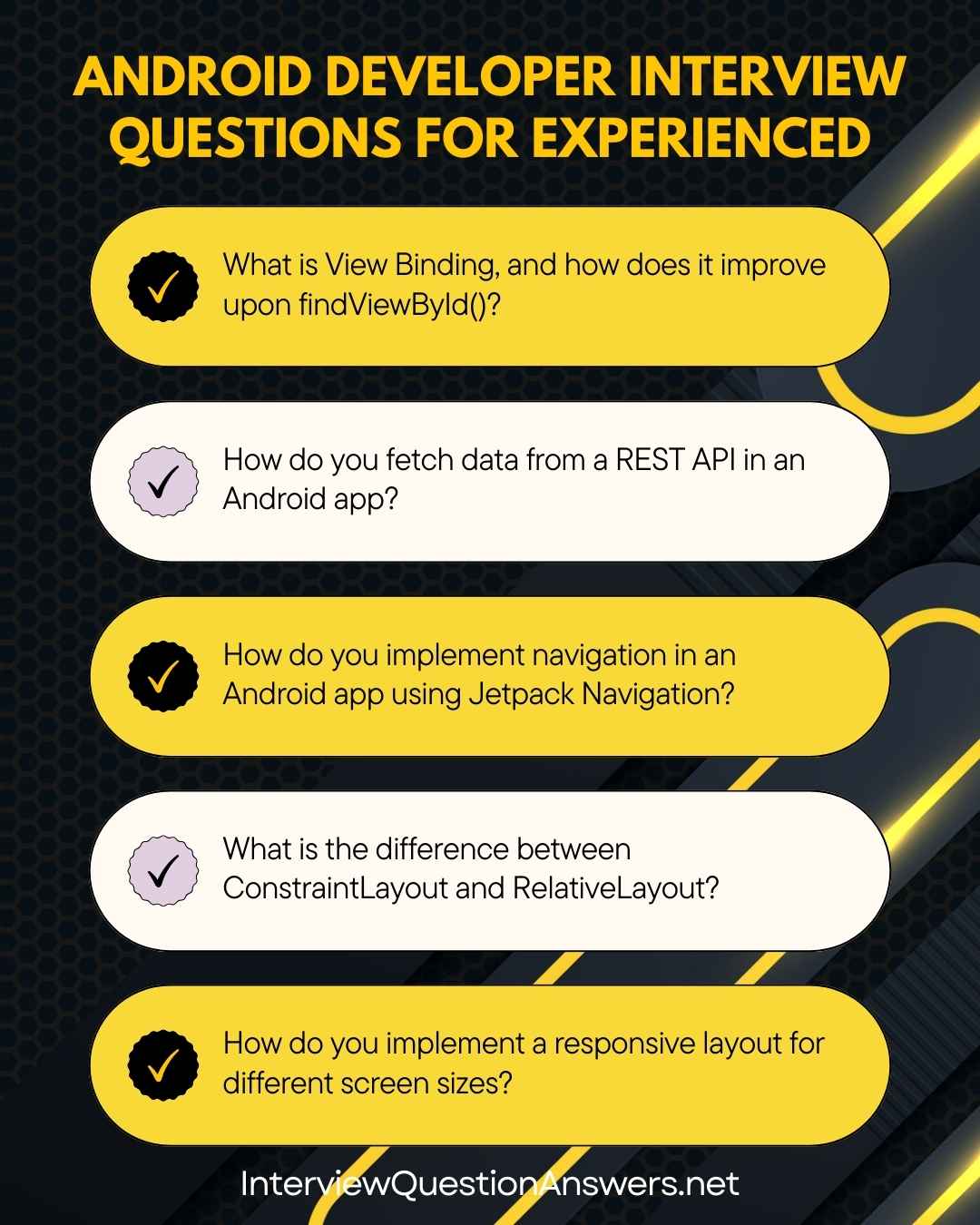
Also Check: Android Developer Interview Questions for Freshers
Android Developer Interview Questions for 5 Years Experience
Que 21. How do you implement a scalable architecture for an Android app with a backend integration?
Answer:
Use MVVM with Jetpack components (ViewModel, LiveData/Flow) for the frontend, integrating with a REST or GraphQL backend via Retrofit. Implement dependency injection with Hilt, cache data with Room or Redis, and use WorkManager for background tasks. Ensure scalability with modular code, efficient API calls, and monitoring via Firebase Performance Monitoring.
@HiltViewModel
class UserViewModel @Inject constructor(private val apiService: ApiService) : ViewModel() {
val users = MutableStateFlow<List<User>>(emptyList())
fun fetchUsers() = viewModelScope.launch {
users.value = apiService.getUsers()
}
}Que 22. How do you optimize an Android app for performance across diverse devices?
Answer:
Optimize layouts with ConstraintLayout, use vector drawables, and enable R8 for code shrinking. Cache network data with OkHttp, use Paging Library for large datasets, and profile with Android Studio’s Profiler. Test on low-end devices and emulators to ensure compatibility.
// Paging Library
val pagingConfig = PagingConfig(pageSize = 20)
val pager = Pager(pagingConfig) { UserPagingSource(apiService) }
val usersFlow = pager.flow.cachedIn(viewModelScope)Que 23. How do you implement real-time data syncing in an Android app?
Answer:
Use Firebase Realtime Database or WebSockets (e.g., OkHttp WebSocket) for real-time updates. Combine with Room for local caching and LiveData/Flow for UI updates. Handle conflicts with versioning or CRDTs and monitor latency with Firebase Analytics.
val database = Firebase.database.reference
database.child("messages").addValueEventListener(object : ValueEventListener {
override fun onDataChange(snapshot: DataSnapshot) {
// Update UI
}
override fun onCancelled(error: DatabaseError) {
// Handle error
}
})Que 24. How do you secure an Android app against reverse engineering?
Answer:
Use ProGuard or R8 for code obfuscation, encrypt sensitive data with Jetpack Security, and store keys in Android Keystore. Implement runtime checks for rooted devices and use HTTPS with certificate pinning for network security.
// Certificate pinning with OkHttp
val client = OkHttpClient.Builder()
.certificatePinner(CertificatePinner.Builder()
.add("api.example.com", "sha256/...")
.build())
.build()Que 25. How do you implement dependency injection with Hilt in an Android app?
Answer:
Use Hilt to provide dependencies via modules and components. Annotate classes with @Inject and define modules with @Provides. Scope dependencies to Activity, Fragment, or ViewModel lifecycles.
@Module
@InstallIn(SingletonComponent::class)
object AppModule {
@Provides
fun provideApiService(): ApiService = Retrofit.Builder()
.baseUrl("https://api.example.com/")
.build()
.create(ApiService::class.java)
}
@HiltViewModel
class MyViewModel @Inject constructor(private val apiService: ApiService) : ViewModel()Que 26. How do you handle large datasets in an Android app with the Paging Library?
Answer:
Use Jetpack Paging Library to load data incrementally from Room or a network source. Implement a PagingSource and use Pager with Flow to update the UI efficiently.
class UserPagingSource(private val apiService: ApiService) : PagingSource<Int, User>() {
override suspend fun load(params: LoadParams<Int>): LoadResult<Int, User> {
val page = params.key ?: 1
return try {
val data = apiService.getUsers(page)
LoadResult.Page(data, prevKey = if (page == 1) null else page - 1, nextKey = page + 1)
} catch (e: Exception) {
LoadResult.Error(e)
}
}
}Que 27. How do you implement push notifications with Firebase Cloud Messaging?
Answer:
Configure FCM, handle tokens in FirebaseMessagingService, and display notifications using NotificationCompat. Customize notification channels for Android 8.0+ and handle background messages.
class MyFirebaseService : FirebaseMessagingService() {
override fun onMessageReceived(message: RemoteMessage) {
val notification = NotificationCompat.Builder(this, "channel_id")
.setContentTitle(message.notification?.title)
.setContentText(message.notification?.body)
.setSmallIcon(R.drawable.ic_notification)
.build()
NotificationManagerCompat.from(this).notify(1, notification)
}
}Que 28. How do you handle memory leaks in an Android app?
Answer:
Use LeakCanary to detect leaks, avoid static references to Activities, and clean up observers in ViewModels. Use WeakReferences for listeners and profile memory with Android Studio’s Profiler.
class MyViewModel : ViewModel() {
override fun onCleared() {
// Clean up resources
super.onCleared()
}
}Que 29. How do you implement unit and integration testing in an Android app?
Answer:
Use JUnit and Mockito for unit tests on ViewModels and utilities. Use Espresso or Robolectric for UI and integration tests. Mock network responses with MockWebServer and automate with CI/CD.
@Test
fun testViewModel() {
val mockApi = mock<ApiService>()
val viewModel = MyViewModel(mockApi)
whenever(mockApi.getUsers()).thenReturn(listOf(User(1, "John")))
viewModel.fetchUsers()
assertEquals("John", viewModel.users.value?.first()?.name)
}Que 30. How do you optimize an Android app for battery efficiency?
Answer:
Use WorkManager for background tasks, batch network requests, and avoid wakelocks. Schedule tasks with constraints (e.g., charging state) and monitor with Battery Historian.
val workRequest = OneTimeWorkRequestBuilder<MyWorker>()
.setConstraints(Constraints.Builder().setRequiresCharging(true).build())
.build()
WorkManager.getInstance(context).enqueue(workRequest)Android Developer Interview Questions for 7 Years Experience
Que 31. How do you implement navigation with safe args in Jetpack Navigation?
Answer:
Define arguments in the navigation graph and use safe args to pass type-safe data between destinations, generating helper classes for navigation.
<!-- nav_graph.xml -->
<fragment android:id="@+id/homeFragment">
<action android:id="@+id/action_to_details" app:destination="@id/detailsFragment">
<argument android:name="userId" app:argType="integer" />
</action>
</fragment>val action = HomeFragmentDirections.actionToDetails(userId = 123)
findNavController().navigate(action)Que 32. How do you handle database migrations with Room?
Answer:
Use Room’s @Database with a version number and define migrations with Migration objects. Test migrations in a staging environment and provide fallback strategies.
@Database(entities = [User::class], version = 2)
abstract class AppDatabase : RoomDatabase() {
abstract fun userDao(): UserDao
}
val MIGRATION_1_2 = object : Migration(1, 2) {
override fun migrate(database: SupportSQLiteDatabase) {
database.execSQL("ALTER TABLE user ADD COLUMN email TEXT")
}
}Que 33. How do you implement a custom View in Android?
Answer:
Extend View or ViewGroup, override onDraw() for rendering, and handle touch events in onTouchEvent(). Use custom attributes for configurability.
class CustomView(context: Context, attrs: AttributeSet?) : View(context, attrs) {
override fun onDraw(canvas: Canvas) {
canvas.drawRect(0f, 0f, 100f, 100f, Paint().apply { color = Color.BLUE })
}
}Que 34. How do you handle different screen densities and sizes in Android?
Answer:
Use dp and sp units, provide alternative layouts (e.g., layout-sw600dp), and use ConstraintLayout for flexibility. Test with emulators and real devices via Firebase Test Lab.
<!-- res/layout-sw600dp/main_activity.xml -->
<ConstraintLayout
android:layout_width="match_parent"
android:layout_height="match_parent">
<!-- Tablet-specific layout -->
</ConstraintLayout>Que 35. How do you implement state management with Jetpack Compose?
Answer:
Use remember and mutableStateOf for local state, and ViewModel with StateFlow for persistent state. Update UI reactively with composables.
@Composable
fun MyScreen(viewModel: MyViewModel = viewModel()) {
val state by viewModel.state.collectAsState()
Text(text = state.text)
}
@HiltViewModel
class MyViewModel @Inject constructor() : ViewModel() {
val state = MutableStateFlow(State(text = "Hello"))
}Que 36. How do you secure API calls in an Android app?
Answer:
Use HTTPS with certificate pinning via OkHttp, validate responses, and store tokens in EncryptedSharedPreferences. Implement retry logic for transient errors.
val client = OkHttpClient.Builder()
.certificatePinner(CertificatePinner.Builder()
.add("api.example.com", "sha256/...")
.build())
.build()Que 37. How do you implement offline support in an Android app?
Answer:
Cache data with Room for local storage, use WorkManager for background sync, and handle network state changes with ConnectivityManager. Provide UI feedback for offline mode.
val networkCallback = object : ConnectivityManager.NetworkCallback() {
override fun onAvailable(network: Network) {
// Sync data
}
}Que 38. How do you implement a GraphQL API integration in an Android app?
Answer:
Use Apollo Client for GraphQL queries, defining schemas and generating models. Handle responses in ViewModel and cache with Apollo’s normalized cache.
val apolloClient = ApolloClient.Builder()
.serverUrl("https://api.example.com/graphql")
.build()
viewModelScope.launch {
val response = apolloClient.query(GetUsersQuery()).execute()
// Process response
}Que 39. How do you handle crashes and report them in an Android app?
Answer:
Use Firebase Crashlytics to capture and report crashes. Implement custom exception handling and log stack traces for debugging.
FirebaseCrashlytics.getInstance().recordException(exception)Que 40. How do you test an Android app for performance and reliability?
Answer:
Use Android Studio’s Profiler for CPU, memory, and network analysis. Test UI with Espresso, integration with Robolectric, and real devices via Firebase Test Lab. Automate with CI/CD pipelines like GitHub Actions.
@Test
fun testUi() {
Espresso.onView(withId(R.id.button)).perform(click())
Espresso.onView(withId(R.id.textView)).check(matches(withText("Clicked")))
}Android Developer Interview Questions for 10 Years Experience
Que 41. How do you architect an Android app for global scalability with millions of users?
Answer:
Design with modular MVVM architecture using Jetpack Compose for UI and Hilt for dependency injection. Integrate with a microservices backend via gRPC or GraphQL for low-latency communication. Use Firebase for real-time features and WorkManager for background sync. Cache aggressively with Room and Redis, deploy on Kubernetes for backend scaling, and monitor with Firebase Performance Monitoring and Prometheus.
@HiltViewModel
class GlobalViewModel @Inject constructor(private val apiService: ApiService) : ViewModel() {
val data = Pager(PagingConfig(pageSize = 20)) { DataPagingSource(apiService) }.flow.cachedIn(viewModelScope)
}Que 42. How do you ensure zero-downtime updates for an Android app in production?
Answer:
Use feature flags with Firebase Remote Config for incremental rollouts. Implement dynamic module delivery with Play Feature Delivery for seamless updates. Test updates in staging with Firebase App Distribution, monitor with Crashlytics, and ensure backend APIs remain backward-compatible.
FirebaseRemoteConfig.getInstance().fetchAndActivate().addOnCompleteListener { task ->
if (task.isSuccessful) {
val featureEnabled = FirebaseRemoteConfig.getInstance().getBoolean("new_feature")
// Toggle feature
}
}Que 43. How do you implement real-time collaboration in an Android app with a backend?
Answer:
Use WebSockets with OkHttp or Firebase Realtime Database for real-time updates. Implement CRDTs or operational transforms for conflict resolution, cache locally with Room, and sync via WorkManager. Optimize with Redis pub/sub on the backend and monitor latency with Datadog.
val client = OkHttpClient()
val request = Request.Builder().url("wss://api.example.com").build()
val webSocket = client.newWebSocket(request, object : WebSocketListener() {
override fun onMessage(webSocket: WebSocket, text: String) {
// Update UI
}
})Que 44. How do you secure an Android app against advanced threats like reverse engineering and data breaches?
Answer:
Obfuscate code with R8, use Android Keystore for key management, and implement runtime checks for rooted devices with SafetyNet Attestation. Use certificate pinning with OkHttp, encrypt data with Jetpack Security, and secure backend APIs with mTLS. Audit with Firebase Security Rules and monitor with Crashlytics.
val client = OkHttpClient.Builder()
.certificatePinner(CertificatePinner.Builder()
.add("api.example.com", "sha256/...")
.build())
.build()Que 45. How do you optimize an Android app for battery and network efficiency?
Answer:
Use WorkManager for deferred tasks, batch network requests with OkHttp, and leverage Doze mode optimizations. Cache responses with Room or Retrofit, use compressed payloads (e.g., Protobuf), and monitor with Battery Historian and Firebase Performance Monitoring.
val workRequest = PeriodicWorkRequestBuilder<SyncWorker>(15, TimeUnit.MINUTES)
.setConstraints(Constraints.Builder().setRequiredNetworkType(NetworkType.CONNECTED).build())
.build()
WorkManager.getInstance(context).enqueue(workRequest)Que 46. How do you implement a multi-tenant architecture in an Android app?
Answer:
Isolate tenant data in Room with separate tables or databases per tenant. Use Hilt to inject tenant-specific dependencies, fetch tenant data via a backend API with tenant IDs in headers, and render tenant-specific UI with Jetpack Compose. Monitor tenant metrics with Firebase Analytics.
@Module
@InstallIn(SingletonComponent::class)
object TenantModule {
@Provides
fun provideDatabase(@Named("tenantId") tenantId: String): AppDatabase = Room.databaseBuilder(context, AppDatabase::class.java, "db-$tenantId").build()
}Que 47. How do you test an Android app for performance and reliability across devices?
Answer:
Use Android Studio’s Profiler for CPU, memory, and network analysis. Run UI tests with Espresso, integration tests with Robolectric, and real-device tests with Firebase Test Lab. Simulate edge cases (e.g., low battery, poor network) and automate with CI/CD pipelines like GitHub Actions.
@Test
fun testNavigation() {
Espresso.onView(withId(R.id.button)).perform(click())
Espresso.onView(withId(R.id.detailsFragment)).check(matches(isDisplayed()))
}Que 48. How do you implement a GraphQL API integration with Apollo in an Android app?
Answer:
Use Apollo Client to define GraphQL queries and mutations, generate models, and cache responses with normalized caching. Integrate with ViewModel for reactive UI updates and handle errors with sealed classes.
val apolloClient = ApolloClient.Builder()
.serverUrl("https://api.example.com/graphql")
.build()
viewModelScope.launch {
val response = apolloClient.query(GetUsersQuery()).execute()
// Update UI
}Que 49. How do you handle database migrations in a production Android app?
Answer:
Use Room’s Migration class to manage schema changes, test migrations in staging, and provide fallback destructive migrations. Backup data with WorkManager syncs and ensure backward-compatible APIs.
@Database(entities = [User::class], version = 2)
abstract class AppDatabase : RoomDatabase() {
abstract fun userDao(): UserDao
}
val MIGRATION_1_2 = object : Migration(1, 2) {
override fun migrate(database: SupportSQLiteDatabase) {
database.execSQL("ALTER TABLE user ADD COLUMN email TEXT")
}
}Que 50. How do you ensure accessibility (a11y) in an Android app?
Answer:
Use semantic views, add contentDescription for images, and support screen readers with TalkBack. Test with Accessibility Scanner and ensure UI elements are navigable via keyboard. Implement dynamic font scaling with sp units.
<ImageView
android:layout_width="wrap_content"
android:layout_height="wrap_content"
android:contentDescription="@string/image_desc" />Conclusion
We have already shared the questions for Android Developer Interview Questions for Experienced, covering in-depth, real-world, and scenario-based topics to help you master advanced concepts. This Android Developer Interview Questions for Experienced Guide includes everything you need to refine your technical knowledge and boost your interview confidence.
As the mobile app development industry continues to evolve with modern frameworks, AI integration, and cross-platform solutions, companies expect developers to stay ahead of trends and deliver high-performing apps. By using this guide, you can strengthen your expertise, showcase your problem-solving skills, and position yourself as a top candidate in the Android development job market.
Similar Interview Guide:

